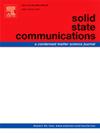Study of the magnetic and structural properties of the simple perovskite YFeO3
IF 2.1
4区 物理与天体物理
Q3 PHYSICS, CONDENSED MATTER
引用次数: 0
Abstract
In the present work, an experimental and theoretical study of the synthesis, magnetic, and structural properties of simple perovskite compounds YFeO3 has been investigated based on their potential applications, such as: solid oxide fuel cells, electrochemical sensors, sensor materials, magneto-optical materials, etc. Experimentally, the synthesis was carried out by the sol-gel method. X-rays and Rietveld refinements confirmed the orthorhombic structure. Scanning electron microscopy observations confirmed agglomerates of simple perovskite particles YFeO3. The study of the magnetic phase of the simple perovskite YFeO3 showed that it behaves like a weak ferromagnetic, this property delimits and directs magnetic fields into well-defined trajectories. On the other hand, the structural results, from a theoretical point of view, are in good agreement with the experimental ones. Through energy comparison, a possible competition was identified between the FM and AFM states, where the electronic properties are associated with the directional nature of the hybridization between the p orbitals of oxygen and the t2g states, where the superexchange mechanism prevails with e oxygen as mediator.
简单过氧化物 YFeO3 的磁性和结构特性研究
本研究从固体氧化物燃料电池、电化学传感器、传感材料、磁光材料等的潜在应用出发,对简单过氧化物化合物 YFeO3 的合成、磁性和结构特性进行了实验和理论研究。实验采用溶胶-凝胶法进行合成。X 射线和里特维尔德精炼证实了其正方体结构。扫描电子显微镜观察证实了简单的包晶颗粒 YFeO3 的团聚。对简单包晶YFeO3磁性相的研究表明,它的行为类似于弱铁磁性,这种特性限定并引导磁场进入定义明确的轨迹。另一方面,从理论角度来看,结构结果与实验结果十分吻合。通过能量比较,确定了调频态和调幅态之间可能存在的竞争,其电子特性与氧的 p 轨道和 t2g 态之间杂化的方向性有关,其中以 e 氧为中介的超交换机制占主导地位。
本文章由计算机程序翻译,如有差异,请以英文原文为准。
求助全文
约1分钟内获得全文
求助全文
来源期刊

Solid State Communications
物理-物理:凝聚态物理
CiteScore
3.40
自引率
4.80%
发文量
287
审稿时长
51 days
期刊介绍:
Solid State Communications is an international medium for the publication of short communications and original research articles on significant developments in condensed matter science, giving scientists immediate access to important, recently completed work. The journal publishes original experimental and theoretical research on the physical and chemical properties of solids and other condensed systems and also on their preparation. The submission of manuscripts reporting research on the basic physics of materials science and devices, as well as of state-of-the-art microstructures and nanostructures, is encouraged.
A coherent quantitative treatment emphasizing new physics is expected rather than a simple accumulation of experimental data. Consistent with these aims, the short communications should be kept concise and short, usually not longer than six printed pages. The number of figures and tables should also be kept to a minimum. Solid State Communications now also welcomes original research articles without length restrictions.
The Fast-Track section of Solid State Communications is the venue for very rapid publication of short communications on significant developments in condensed matter science. The goal is to offer the broad condensed matter community quick and immediate access to publish recently completed papers in research areas that are rapidly evolving and in which there are developments with great potential impact.
 求助内容:
求助内容: 应助结果提醒方式:
应助结果提醒方式:


